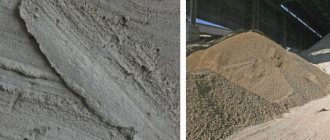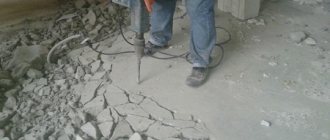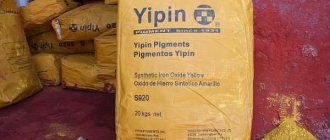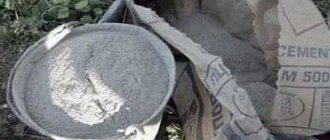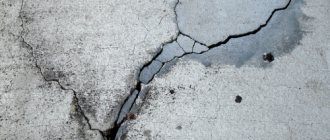Before carrying out any repair work related to finishing the concrete surface, it is recommended to thoroughly clean it of various contaminants. Since concrete has a porous structure, contaminants “eat” into it quite strongly and sometimes it can be incredibly difficult to clean them off. Modern chemicals for cleaning concrete help cope with this task.
Scope of application of concrete cleaning products
Before applying any protective or decorative coating to a concrete base, a large amount of preparatory work is required. Experts recommend cleaning the concrete surface from the cement film in order to open the pores of the material in order to ensure deeper penetration of the chemical composition into the concrete structure. Concrete cleaning is also carried out to eliminate the “cold seam”, carry out cut-off waterproofing, perform work with self-leveling floors and other processes that require high-quality adhesion of concrete to the applied coating.
Chemicals for cleaning concrete allow you to quickly dissolve the cement film and open the pores of the material
The use of these compositions promotes deeper penetration of chemically active substances into concrete and increases the adhesion strength of concrete to a waterproofing or decorative coating by 1.5-3 times. Cleaning compositions are also used when it is necessary to remove stains of fuels and lubricants, bitumen, old paint and other contaminants from the concrete surface .
Modern chemicals significantly reduce the labor intensity of preparing concrete bases before applying protective and decorative coatings. The action of chemical cleaners is based on the corrosion of the surface layer of concrete by the acidic components present in the composition of these products.
Using potent compounds, you can clean various building materials: concrete slabs, monoliths, brick and stone masonry, paving slabs, etc. By chemical means they can be very effectively cleaned of cement mortar residues, mold, efflorescence, fungi and other contaminants . Chemical cleaning can be either an independent operation or a preparatory stage before further mechanical treatment of the concrete surface.
Operating principle
Various cleaners operate on the same principle: they gently destroy the concrete structure without affecting the original coating material. Main components:
- acid for destroying concrete in concentrated form;
- active inhibitors that prevent the development of corrosion;
- components that protect metal elements from destruction.
The acid penetrates into each layer of the solution and destroys it. The concrete comes loose gradually and is easily washed off with water or cleaned off by hand. This method is used to clean glass, wood, metal, ceramic tiles, and brick. Suitable for putting tools in order after construction work.
Return to contents
Application of means for cleaning concrete from cement film
The cement film is a fragile crystalline structure that fills the pore space of concrete.
The main source of the formation of this film is an aqueous solution of calcium hydroxide, which comes out with water to the surface of the concrete, where it reacts with carbon dioxide present in the air and forms a film of calcium carbonate, insoluble in water. According to its chemical composition, cement film (cement laitance) is limestone.
Another source of the formation of laitance is alkali metal salts present in free form in cement. These salts emit zeolite tuffs and ash waste from thermal power plants, which are added to cement during its production, as well as sand, gravel, crushed stone, hardening accelerators, plasticizers, antifreeze additives and other modifying materials added to the concrete mixture for various purposes.
When applying any coating to a concrete surface with a cement film, instead of the expected monolith, a three-layer structure “concrete base - cement film - coating” is obtained. Each layer of this three-layer structure absorbs mechanical load independently and works independently of the others. The weakest point of the structure is precisely the laitance layer . Therefore, it is quite obvious that destruction at a threshold stress will occur along the boundaries of this layer.
The cement film is the boundary at which shrinkage compressive stresses turn into tensile stresses, so the joint zone becomes prestressed. As you know, concrete works well in compression, but has rather low resistance to bending loads and very poorly withstands tensile stresses. Due to the relaxation of tensile stresses, which are realized in the form of microcracks, the joint zone acquires lower strength and density compared to a monolithic surface at equal tensile stresses.
To remove the cement film, mechanical and chemical methods are used . Each of these methods has its own advantages and disadvantages.
The productivity of chemical treatment is 150-700 sq. m/hour depending on the product used and the degree of surface contamination
The first is associated with the use of expensive equipment, high labor intensity and some restrictions on access to various parts of concrete structures, so chemical cleaning of concrete is currently widely used.
Cleaning concrete with acid
Acid cleaning is also called acid etching. Acid etching effectively removes the cement film from the surface of concrete. But managing this process is quite difficult . When using it, it is almost impossible to evenly clean the entire surface of a concrete structure. Among the disadvantages of this method, it should also be noted the possibility of the corrosive effect of acid cleaners on steel reinforcement present in building structures made of reinforced concrete.
When acid etching concrete, hydrochloric, acetic or phosphoric acid is used, diluted to 10-15 percent concentration. The recommended flow rate is 0.5 l/m2. The chemical reaction lasts approximately five minutes and is accompanied by the formation of bubbles . After foaming has stopped, the surface should be thoroughly washed with water and cleaned of loose concrete. If necessary, repeat the procedure.
Acid etching technology
Cleaning a concrete surface with acid consists of several stages:
- The concrete surface is thoroughly cleaned of oil stains and dirt using detergents. It should be taken into account that any stains impede quality etching.
- The acid should be applied to a small area first to see how it will react with the surface (acid reacts differently on each type of surface). If partial destruction of concrete occurs in the test area, the acid should be changed to a weaker solution in percentage terms.
- After the applied acid reacts with the laitance, the treated surface must be thoroughly rinsed with warm water.
- After washing the concrete surface with water, let it dry thoroughly and only then begin finishing it.
When cleaning concrete with acid, the recommended concentration of the composition used must be strictly observed. Otherwise, there is a risk of eliminating not only the laitance layer, but also damaging the “body” of the concrete itself. In this regard, it is more convenient and safe to use ready-made chemicals for cleaning concrete . Such products are now offered by many manufacturers of household and industrial chemicals.
Benefits of using chemicals to clean concrete:
- dissolution and removal of laitance without destroying the cement stone;
- increasing the penetration depth of the chemically active part of waterproofing materials and other coatings;
- elimination of “cold seams” with the creation of monoliths;
- reducing the labor intensity and cost of concrete cleaning work.
Complex concrete cleaning agent HimFrez
The use of the HimFrez chemical complex completely eliminates the use of manual mechanical cleaning of the concrete base, as well as machine milling, sand, shot and water blasting
A comprehensive product for chemical milling of concrete consists of two ready-to-use water-based compositions: ChemFrez Cleaner and ChemFrez Activator. The first is an acid cleaner and is used to remove cement film.
It also opens the pores of the concrete and increases the depth of penetration of coatings into the concrete base. HimFrez Activator is an alkaline activator that adhesively activates the cleaned surface and helps increase the adhesion strength of coatings to concrete.
The complex product HimFrez is used to prepare concrete bases for application:
- compositions for repairing concrete surfaces;
- cement and magnesium screeds;
- monolithic concrete;
- penetrating waterproofing materials;
- polyurethane, acrylate, silicone, bitumen and thiokol sealants;
- tile adhesives;
- cement, polymer cement, gypsum, magnesia, acrylate, polyurethane, epoxy plasters;
- self-leveling floors.
HimFrez Cleaner effectively dissolves cement laitance and opens the pores of concrete without entering into a chemical reaction with the crystalline structure of the cement stone and without disturbing it.
The second component of ChemFrez Activator is applied to the cleaned surface an hour after using the cleaner and adhesively activates it. The required coating is applied to the concrete surface an hour after completion of the chemical treatment .
In some cases, chemical milling eliminates the need to use plaster mesh. In addition, this method is characterized by high productivity and cost-effectiveness.
Examples of manufacturers
There are many brands of cleaners: bio decap concrete guard, barracuda 10K, EK 100 Super, Aquarius, B 100 T and others.
The most common:
Return to contents
Barracuda 10K
A product that cleans molds, vehicles, tools well from mortars and concrete mixture residues. Suitable for removing concrete, plaster, cement, mineral deposits from the surface of swimming pools, facades, windows, tiles, construction mixers. The absence of acids in the product allows it to be used to clean any material, even coated with paint.
Barracuda 10K – high-quality concrete cleaner:
- removes solution residues;
- has no unpleasant odor;
- easily decomposes in the natural environment;
- does not affect glass, chrome;
- safe for human skin.
The safety of the components allows it to be used for any type of equipment and to withstand for a long time. The chemical is easily and quickly washed off with water. There are no contraindications for use.
Return to contents
Divinol Betonloser
An imported cleaner that removes cement, chalk, and rust. Suitable for cleaning vehicles transporting concrete and construction tools. Used both in concentrated and diluted form. Application is carried out with good ventilation. After use, rinse the surface thoroughly with cold water . Application on aluminum, chrome and brass coatings is not possible.
Return to contents
EK 100 Super
It is a red liquid with an unpleasant odor. Components: mineral acids, inhibitors, additional additives. Its vapors are dangerous to humans. Removes:
- traces of cement laitance;
- oxides, rust, lime residues.
Most often used for cleaning equipment, tools, heat exchangers. It is strictly prohibited to use EK 100 Super for:
- wood;
- polymer-based coatings;
- rubber and PVC coverings;
- linoleum covering;
- marble covering;
- carpet
Return to contents
Aquarius
Aquarius is an effective concrete mold remover. The basis is organosilicon compounds (silicones). It is characterized by high safety for people and operational capabilities. Cleans any surface from fungus and mold: slate, concrete, brick, stone. Suitable for basements, cellars, bathrooms as a disinfectant
The Aquarius cleaner makes the treated area lighter and returns it to its natural color. Re-application is not required, it does not need to be washed off with water and will act as an antiseptic. Thanks to the silicone in its composition, Aquarius has moisture-proof properties . Treating external walls increases their thermal insulation and prevents the appearance of mold.
The product is applied by spraying, roller or brush. Each layer must dry. How many layers to apply depends on the condition of the treatment area and environmental conditions. The drug is popular with consumers due to its many benefits and affordable price.
Advantages of the “Aquarius” cleaner:
- destruction of fungi, biological pollutants;
- long lasting effect;
- returning the problem area to its original appearance;
- removing traces of leaks;
- resistance to washout;
- safety.
The Aquarius cleaner performs the following functions:
- brightens areas that have darkened over time;
- kills pathogenic microflora, mold;
- protects the premises and building elements from destruction by moisture.
The drug is applied undiluted to a dry surface. If liquid gets on the glass, you need to wipe it off within 30 minutes so that no traces remain.
Other cleaners:
- bio decap concrete guard;
- Neomid 600;
- heavy mineral trace cleaner EC-91;
- oil and grease stains EC-90;
- Spektrin Cleaner;
- Liquid Monster.
Return to contents
Cleaning concrete from efflorescence
Sometimes light spots of irregular shape appear on the facades of buildings after construction. These stains are called efflorescence and are the result of crystallization of salts on surfaces. Efflorescence can occur on any materials with a porous structure, such as concrete and brick .
Salt solutions inside such materials can move freely, and in warm and dry weather they rush to the surface of the walls, where the moisture evaporates and the salts crystallize and remain on the walls in the form of a white coating.
Efflorescence is dangerous because it contributes to the destruction of building materials . Salts corrode the outer surfaces, which begin to crumble, and precipitation and wind complete the job. Even worse, salts crystallize not only on the surface of concrete or brick, but also in the body of the building material, gradually destroying it from the inside.
As a result, microcracks appear, which over time can cause more serious damage to the walls of the house.
For concrete floors, the main cause of efflorescence is capillary drawing in of groundwater.
Reasons for the formation of efflorescence:
- external influences in the form of precipitation, ultraviolet radiation, etc.;
- the presence of water-soluble salts in building materials;
- use of water with a high content of water-soluble salts for masonry mortars;
- high moisture content in the materials used in the construction of the house, as well as long-term periodic or constant additional moisture, for example, when stored in open areas without proper protection from moisture;
- the use in construction of various plasticizers, antifreeze additives, hardening accelerators for solutions containing nitrites, nitrates, calcium chlorides, etc.;
- temperature and humidity conditions under which slow evaporation of moisture from materials on the surface of the structure occurs;
- violation of the manufacturing technology of building materials, for example, the use of raw materials with a high lime content in the manufacture of bricks.
Most often, the formation of efflorescence is associated with the presence of soluble compounds in the composition of masonry mortars, as well as with atmospheric corrosion and various contaminants of biological origin. In megacities or near highways and industrial enterprises, the atmosphere contains gases that, with high air humidity, form harmful substances such as sulfuric acid.
The acid reacts with calcium hydroxide, which is contained in the masonry mortar, and forms crystalline gypsum, which appears as a plaque on the surface of the walls . The formation of efflorescence is also influenced by the quality of the cement used.
To remove efflorescence, you need to know its chemical nature. Some types of efflorescence can be washed off with plain water, while others are difficult to remove even with the most powerful chemical cleaners. The hardest to clean are calcium, iron, magnesium and barium carbonates, calcium silicate, aluminum orthophosphate and pyrophosphate. For such complex contaminants, it is recommended to use Tiprom Plus.
Chemical agent Tiprom Plus
This product is a slightly colored liquid and is used to clean the facades of buildings made of brick, artificial and natural stone from salt deposits and persistent atmospheric pollution.
Recommendations for applying the composition:
- thoroughly clean the surface from any contaminants present on it;
- Tiprom Plus before application, dilute with water in a ratio of 1:2 – 1:5 (the proportion depends on the scale of efflorescence). Apply the product liberally to the wall surface using a brush or roller;
- after the surface has dried, remove the reaction products with a damp cloth or dry brush;
- in case of high salinity, it is recommended to re-treat;
- after 1-2 days, it is necessary to treat the cleaned surface with a hydrophobizing (water-repellent) composition Tipr K or Tipr M.
Cleaning of efflorescence should be carried out only in dry weather at an air temperature of 0-30 degrees. The surface to be treated must also be dry
Treatment with a water-repellent compound is necessary to prevent moisture from wet snow or slanting rain from entering the walls . It is during the evaporation of water that salt is carried to the surface. After treatment with a water repellent, the frost resistance of the treated material also increases. This is especially important for plastered facades and plinths of buildings, which are most susceptible to damage from frost and water.
To prevent the formation of efflorescence, it is recommended:
- When preparing mortar, use quartz sand as a filler, which does not contain sulfate salts, as well as sand obtained by crushing rocks (dense sandstone, granite, diabase, etc.). Sand mined in quarries or river sand must be thoroughly washed with water to remove clay and organic impurities from it;
- When preparing mortar, use only those plasticizing additives that do not contain water-soluble salts. The use of detergent-based additives is strictly prohibited;
- limit the mobility of the solution, that is, use a rigid solution. This solution does not slide down the spatula when it is tilted at an angle of 45 degrees;
- do not use sodium nitrate, potash, table salt, etc. as an antifreeze additive for mortar;
- perform masonry with a recessed seam;
- compact the vertical and horizontal joints of the masonry as much as possible;
- protect the masonry from precipitation. After completion of the work, the masonry should be covered with plastic film or some other waterproof material;
- do not carry out laying at sub-zero temperatures or during rain;
- do not rub the mortar on the front surface of the brick;
- ensure the arrangement of water intake pipes, cornices and canopies;
- prevent capillary absorption of moisture from the soil.
The chemical cleaning method is also relevant when it is necessary to remove machine oil, bitumen and other contaminants from concrete. Oil stains can be removed using detergents or caustic soda solution.
Cleaning is done with a stiff brush followed by rinsing with hot water. On an industrial scale, modern industrial cleaners such as Mazbit Turbo are used to implement the chemical method, which effectively cope with even such complex contaminants as carbon deposits and soot.
Upon completion of work, it is necessary to test the surface for the presence of oil. To do this, water is sprayed onto the area of the surface that has been cleaned after it has dried. If water is absorbed into the concrete, then the cleaning is done well , and if not, then the cleaning should be repeated. If the concrete surface is contaminated to a significant depth, then the layer of concrete with contaminants will have to be removed mechanically.
Review of solvents for concrete (cement): top 4
| Solvent | Properties | Efficiency | Price |
| Himfrez | Does not contain acids, can be used for working with ceramics and decorative items | Penetrates microcracks in cement and can be used simultaneously with blasting | 120 rubles per liter |
| Barracuda | Acid free, can be used on ceramic, plastic and glass surfaces | Fights white plaque on bricks, lime, tile adhesive, does not spoil iron | 600 rubles per liter |
| Lugato | Contains acid and does not damage chrome surfaces | Removes long-dried cement | 500 rubles per liter |
| Prosept | Contains orthophosphoric acid and surfactants | Quickly softens a thin layer of cement, can be used on materials made of wood, plastic and glass | 200 rubles per liter |
Sources used:
- GOST 28013-98 – Construction mortars.
- [Textbook]: “Technology of concrete, building products and structures” – Bazhenov Yu. M., Alimov L. A., et al.
- GOST 25246-82 – Chemically resistant concrete. THAT.
Security measures
The use of chemicals for cleaning concrete is based on the aggressive effects of chemical media. Exposure is indiscriminate due to vapors, drips and splashes.
When treated with chemical compounds:
- embedded parts, exposed reinforcement and the cement stone itself are exposed to corrosion;
- in the presence of electrical communications and electrical equipment, chemical vapors provoke corrosion of contact pairs, which can cause electrical breakdown;
- Workers are exposed to dangerous chemicals.
Therefore, when working with chemical compounds it is necessary to handle very carefully. If they come into contact with the skin, rinse it with plenty of water. Particular care should be taken to avoid getting chemicals in the eyes, as this can cause permanent blindness .
Inhalation of vapors from these compounds should be avoided to avoid burns to the mouth or throat.
During work, you should wear protective clothing made of thick fabric, closed shoes, gloves, goggles and a respirator with a cartridge against acid vapors.
Application of cement solvent
To remove clumps of concrete from shag carpet, soak a sponge in a solvent mixed with dish soap. You can also use alcohol, acetone or glycerin as a solvent. First soak the cement on the carpet for a couple of minutes, then wash it with smooth movements.
To remove cement from an instrument, place it in a container with the prepared solvent and leave it for a while (according to the instructions). Then rinse the instrument in water.
To wash a concrete mixer or car, you can use a special solvent “Barracuda” - it does not contain acid, therefore it is safe for metal and skin; It is environmentally friendly and does not harm the soil, because it completely dissolves. But it’s still worth observing safety precautions.
To remove cement from the machine, you need to do the following:
- Apply the solution to the frozen particles.
- Leave for a few minutes.
- Carefully remove soft particles from the car to avoid scratching.
You can use folk remedies - vinegar, lemon juice or car shampoo.
How to get rid of hardened cement in a concrete mixer: pour solvent into the drum and leave it to rotate for 10 minutes, then wash the drum with a stream of water or improvised means.
To clean products made of plastic, ceramics or glass, solvents such as Barracuda, Bio Decap Beton Guard or Himfrez are used.
Cost of concrete cleaning products
Estimated cost of chemicals used for chemical cleaning of concrete surfaces:
| Name | Purpose | Cost, rub/liter |
| Himfrez Complex | Two in one. Dissolves laitance, opens pores and adhesively activates the surface. | 180 |
| Himfrez Cleaner | Removes cement film and opens concrete pores. | 140 |
| Himfrez Activator | Increases adhesion (adhesion strength) of concrete with cement and polymer coatings. | 140 |
| Mepta HimFrez | Cleaning concrete from cement film, efflorescence, plaque, etc., as well as improving adhesion. | 100 |
| Tiprom Plus | Cleaning facades made of brick, artificial and natural stone from salt deposits, cement mortar residues, and atmospheric pollution. | 90 |
conclusions
Darkening of the facade due to precipitation, the appearance of whitish stains on the walls of the building, mold, mildew, graffiti or oil stains - any of these contaminants can be removed quite simply and quickly using chemicals. Modern manufacturers offer a huge selection of these products, among which you can always find one that will be most optimal for the current situation. The choice of product depends on the initial state of the surface, the material used for its manufacture and the problem that needs to be solved using chemical treatment.
Removing cement laitance from concrete using K6 is shown in the video:



